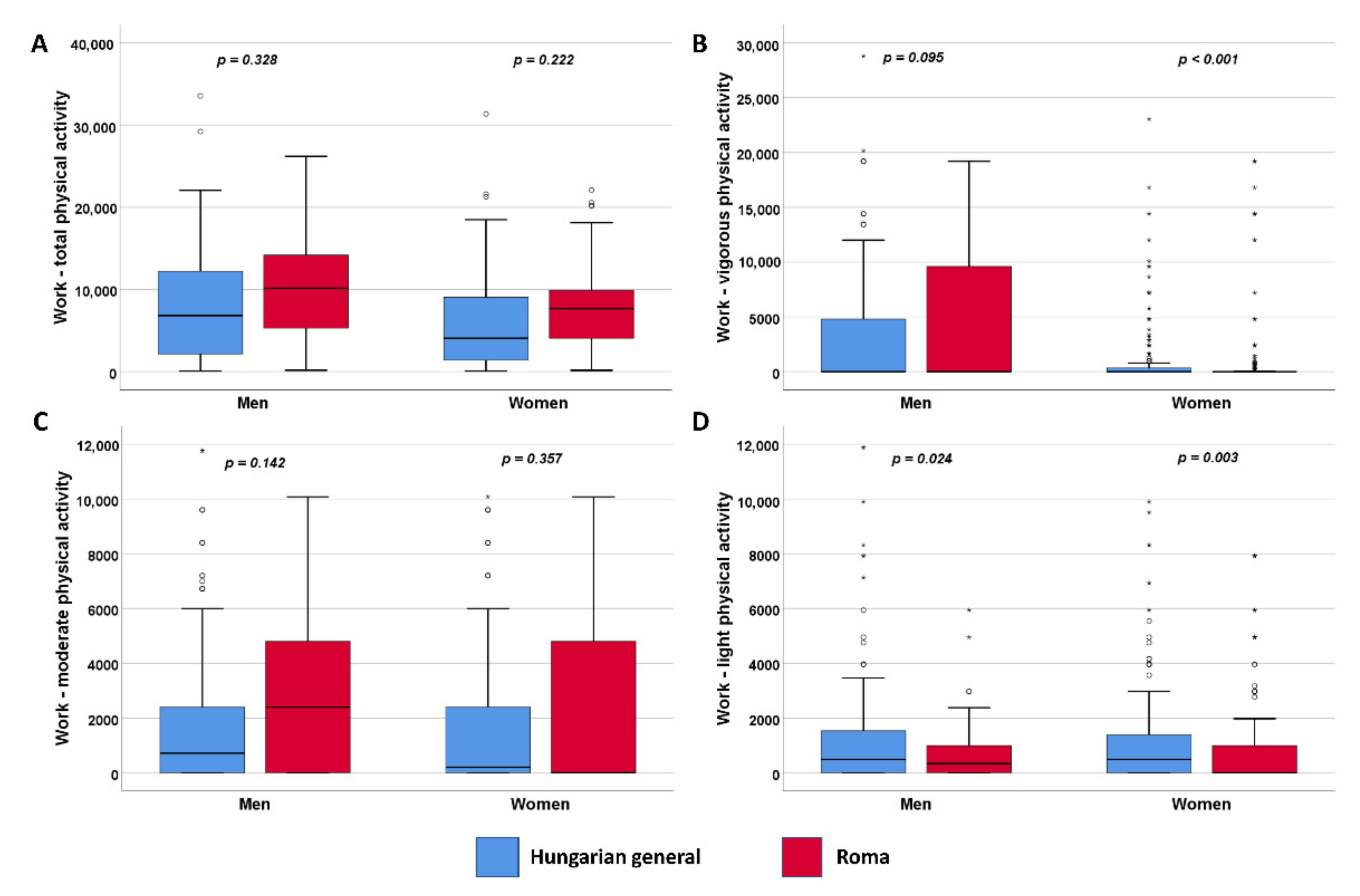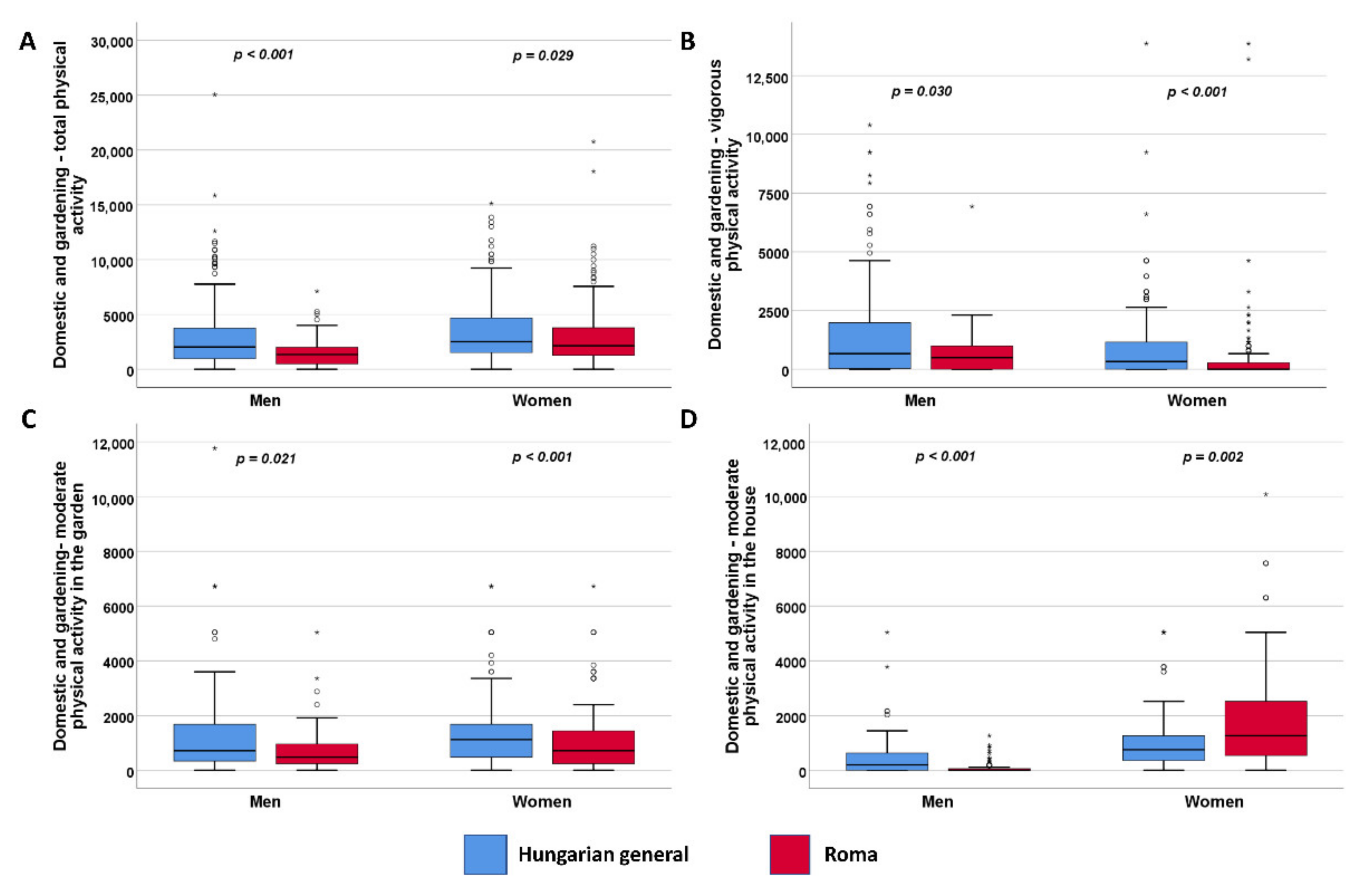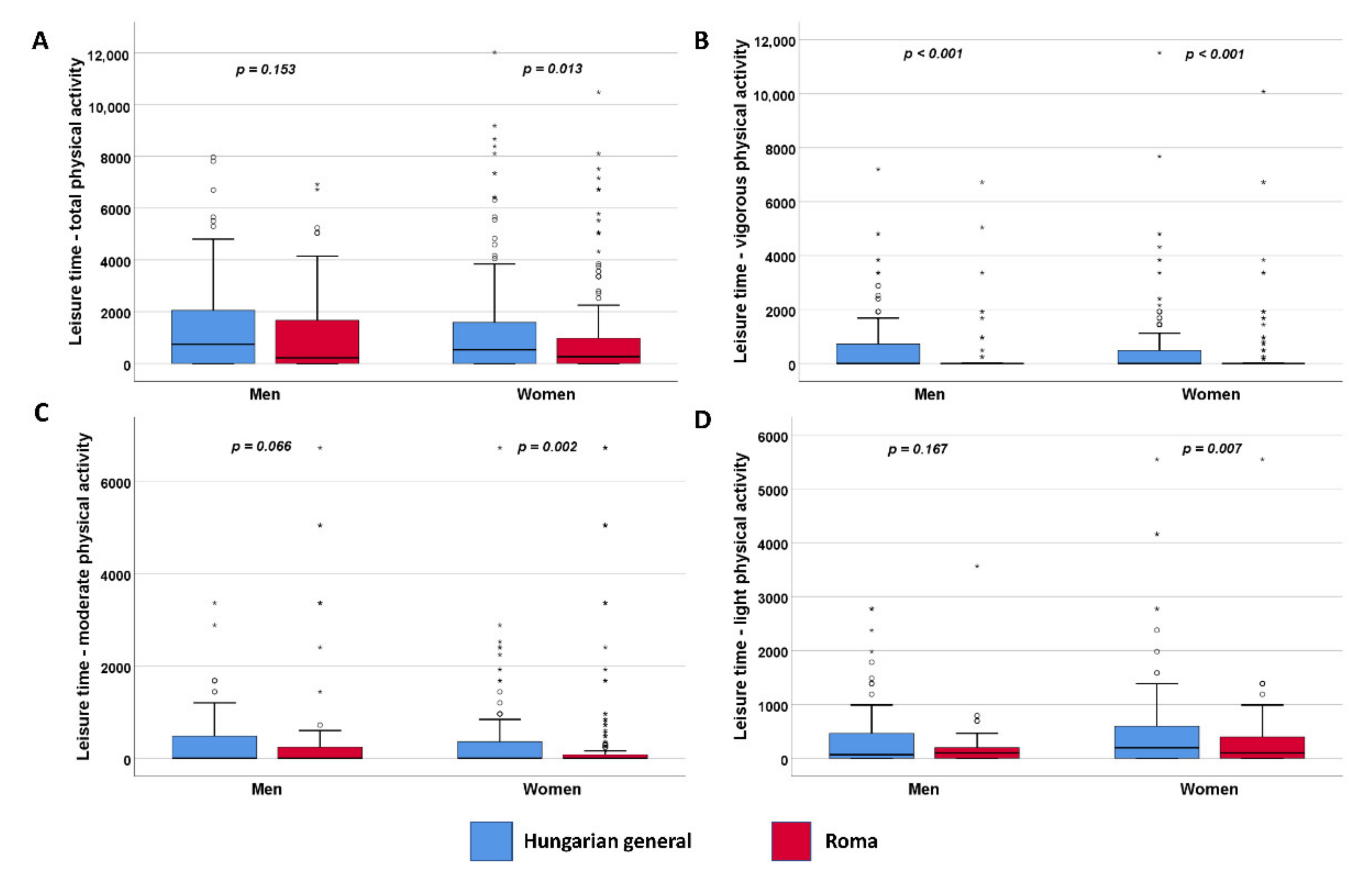Physical Activity Pattern Characterized by Domains and Dimensions of the Roma Population in Comparison with That of the General Population in Northeast Hungary
Abstract
1. Introduction
2. Materials and Methods
2.1. Sample Populations
2.2. Questionnaire-Based Interviews
2.3. Analysis of Data on Physical Activity
- Low physical activity (a minimum total physical activity of at least 600 MET-min/week, but less than 1500 MET-min/week);
- Moderate physical activity (a minimum total physical activity of at least 1500 MET-min/week, but less than 3000 MET-min/week);
- High physical activity (a minimum total physical activity of at least 3000 MET-min/week). All IPAQ data were cleaned and processed by Microsoft Excel Software using the standardised IPAQ Scoring Protocol [39]. The study population consisted of 797 participants (HG: 410 and HR: 387). As a first step, individuals with weekly physical activity greater than 6720 min (6720 min = 16 h × 7 days: There should be no more than 16 h of activity time because 8 h per day is the average sleep time according to the National Sleep Foundation [41]) were excluded (46 individuals). In the second step, 58 individuals were excluded because their record was not complete—693 individuals remained in the sample (HG = 343 and HR = 350).
2.4. Statistical Analysis
2.5. Ethical Statement
3. Results
3.1. Socio-Demographic Characteristics of the Sample
3.2. Physical Activity by Dimensions in the Study Samples
3.3. Physical Activity by Domains in the Study Samples
3.4. Physical Activity Dimensions in Different Domains
4. Discussion
5. Conclusions
Supplementary Materials
Author Contributions
Funding
Institutional Review Board Statement
Informed Consent Statement
Data Availability Statement
Conflicts of Interest
References
- Muller, J. Transforming Our World: The 2030 Agenda for Sustainable Development. Reforming United Nat. 2016, 7, 223–263. [Google Scholar] [CrossRef]
- World Health Organization. Towards a Global Action Plan for Healthy Lives and Well-Being for All: Uniting to Accelerate Progress Toward the Health-Related SDGs; World Health Organization: Geneva, Switzerland, 2018. [Google Scholar]
- European Commission. Roma Equality, Inclusion and Participation in the EU. Available online: https://ec.europa.eu/info/policies/justice-and-fundamental-rights/combatting-discrimination/roma-eu/roma-equality-inclusion-and-participation-eu_en (accessed on 20 February 2022).
- Sudzinova, A.; Nagyova, I.; Studencan, M.; Rosenberger, J.; Skodova, Z.; Vargova, H.; Middel, B.; Reijneveld, S.A.; van Dijk, J.P. Roma coronary heart disease patients have more medical risk factors and greater severity of coronary heart disease than non-Roma. Int. J. Public Health 2013, 58, 409–415. [Google Scholar] [CrossRef] [PubMed]
- Zeljko, H.; Skaric-Juric, T.; Narancic, N.S.; Salihovic, M.P.; Klaric, I.M.; Barbalic, M.; Starcevic, B.; Lauc, L.B.; Janicijevic, B. Traditional CVD risk factors and socio-economic deprivation in Roma minority population of Croatia. Coll. Antropol. 2008, 32, 667–676. [Google Scholar] [PubMed]
- Kosa, Z.; Moravcsik-Kornyicki, A.; Dioszegi, J.; Roberts, B.; Szabo, Z.; Sandor, J.; Adany, R. Prevalence of metabolic syndrome among Roma: A comparative health examination survey in Hungary. Eur. J. Public Health 2015, 25, 299–304. [Google Scholar] [CrossRef]
- Beljic Zivkovic, T.; Marjanovic, M.; Prgomelja, S.; Soldatovic, I.; Koprivica, B.; Ackovic, D.; Zivkovic, R. Screening for diabetes among Roma people living in Serbia. Croat. Med. J. 2010, 51, 144–150. [Google Scholar] [CrossRef]
- Adany, R. Roma health is global ill health. Eur. J. Public Health 2014, 24, 702–703. [Google Scholar] [CrossRef]
- Hujova, Z.; Alberty, R.; Paulikova, E.; Ahlers, I.; Ahlersova, E.; Gabor, D.; Dove, M. The prevalence of cigarette smoking and its relation to certain risk predictors of cardiovascular diseases in central-Slovakian Roma children and adolescents. Cent. Eur. J. Public Health 2011, 19, 67–72. [Google Scholar] [CrossRef]
- Petek, D.; Rotar Pavlic, D.; Svab, I.; Lolic, D. Attitudes of Roma toward smoking: Qualitative study in Slovenia. Croat. Med. J. 2006, 47, 344–347. [Google Scholar]
- Weiss, E.; Japie, C.; Balahura, A.M.; Bartos, D.; Badila, E. Cardiovascular risk factors in a Roma sample population from Romania. Rom. J. Intern. Med. 2018, 56, 193–202. [Google Scholar] [CrossRef]
- Sandor, J.; Kosa, Z.; Boruzs, K.; Boros, J.; Tokaji, I.; McKee, M.; Adany, R. The decade of Roma Inclusion: Did it make a difference to health and use of health care services? Int. J. Public Health 2017, 62, 803–815. [Google Scholar] [CrossRef]
- Olisarova, V.; Tothova, V.; Bartlova, S.; Dolak, F.; Kajanova, A.; Novakova, D.; Prokesova, R.; Sedova, L. Cultural Features Influencing Eating, Overweight, and Obesity in the Roma People of South Bohemia. Nutrients 2018, 10, 838. [Google Scholar] [CrossRef] [PubMed]
- Llanaj, E.; Vincze, F.; Kosa, Z.; Bardos, H.; Dioszegi, J.; Sandor, J.; Adany, R. Deteriorated Dietary Patterns with Regards to Health and Environmental Sustainability among Hungarian Roma Are Not Differentiated from Those of the General Population. Nutrients 2021, 13, 721. [Google Scholar] [CrossRef] [PubMed]
- Ciaian, P.; Cupak, A.; Pokrivcak, J.; Rizov, M. Food consumption and diet quality choices of Roma in Romania: A counterfactual analysis. Food Secur. 2018, 10, 437–456. [Google Scholar] [CrossRef]
- Lin, J.S.; O’Connor, E.; Evans, C.V.; Senger, C.A.; Rowland, M.G.; Groom, H.C. Behavioral counseling to promote a healthy lifestyle in persons with cardiovascular risk factors: A systematic review for the U.S. preventive services task force. Ann. Intern. Med. 2014, 161, 568–578. [Google Scholar] [CrossRef]
- LeFevre, M.L. Behavioral counseling to promote a healthful diet and physical activity for cardiovascular disease prevention in adults with cardiovascular risk factors: U.S. preventive services task force recommendation statement. Ann. Intern. Med. 2014, 161, 587–593. [Google Scholar] [CrossRef]
- Lavie, C.J.; Arena, R.; Blair, S.N. A call to increase physical activity across the globe in the 21st century. Future Cardiol. 2016, 12, 605–607. [Google Scholar] [CrossRef]
- WHO. Global Action Plan On Physical Activity 2018–2030: More Active People for a Healthier World; World Health Organization: Geneva, Switzerland, 2018. [Google Scholar]
- Mattioli, A.V.; Sciomer, S.; Moscucci, F.; Maiello, M.; Cugusi, L.; Gallina, S.; Dei Cas, A.; Lombardi, C.; Pengo, M.; Parati, G.; et al. Cardiovascular prevention in women: A narrative review from the Italian Society of Cardiology working groups on “Cardiovascular Prevention, Hypertension and peripheral circulation” and on “Women Disease”. Cardiovasc. Med. 2019, 20, 575–583. [Google Scholar] [CrossRef]
- Nasi, M.; Patrizi, G.; Pizzi, C.; Landolfo, M.; Boriani, G.; Dei Cas, A.; Cicero, A.F.G.; Fogacci, F.; Rapezzi, C.; Sisca, G.; et al. The role of physical activity in individuals with cardiovascular risk factors: An opinion paper from Italian Society of Cardiology-Emilia Romagna-Marche and SIC-Sport. J. Cardiovasc. Med. 2019, 20, 631–639. [Google Scholar] [CrossRef]
- Ainsworth, B.E. How physically active are our children? A global view. J. Sport Health Sci. 2016, 5, 400. [Google Scholar] [CrossRef]
- Ng, M.; Fleming, T.; Robinson, M.; Thomson, B.; Graetz, N.; Margono, C.; Mullany, E.C.; Biryukov, S.; Abbafati, C.; Abera, S.F.; et al. Global, regional, and national prevalence of overweight and obesity in children and adults during 1980–2013: A systematic analysis for the Global Burden of Disease Study 2013. Lancet 2014, 384, 766–781. [Google Scholar] [CrossRef]
- Papon, C.; Delarche, N.; Le Borgne, C.; Bauduer, F. Assessment of cardiovascular risk factors in a Roma community from Southwestern France. Am. J. Hum. Biol. 2017, 29, e22895. [Google Scholar] [CrossRef]
- Dolinska, S.; Kudlackova, M.; Ginter, E. The prevalence of female obesity in the world and in the Slovak Gypsy women. Bratisl. Lek. Listy 2007, 108, 207–211. [Google Scholar]
- Vozarova De Courten, B.; De Courten, M.; Hanson, R.L.; Zahorakova, A.; Egyenes, H.P.; Tataranni, P.A.; Bennett, P.H.; Vozar, J. Higher prevalence of type 2 diabetes, metabolic syndrome and cardiovascular diseases in gypsies than in non-gypsies in Slovakia. Diabetes Res. Clin. Pract. 2003, 62, 95–103. [Google Scholar] [CrossRef]
- Krajcovicova-Kudlackova, M.; Blazicek, P.; Spustova, V.; Valachovicova, M.; Ginter, E. Cardiovascular risk factors in young Gypsy population. Bratisl. Lek. Listy 2004, 105, 7–8. [Google Scholar]
- Carrasco-Garrido, P.; López De Andrés, A.; Hernández Barrera, V.; Jiménez-Trujillo, I.; Jiménez-García, R. Health status of Roma women in Spain. Eur. J. Public Health 2011, 21, 793–798. [Google Scholar] [CrossRef] [PubMed]
- Enache, G.; Rusu, E.; Ilinca, A.; Rusu, F.; Costache, A.; Jinga, M.; Pănuș, C.; Radulian, G. Prevalence of overweight and obesity in a Roma population from southern Romania-Calarasi county. Acta Endocrinol. 2018, 14, 122. [Google Scholar] [CrossRef]
- Voko, Z.; Csepe, P.; Nemeth, R.; Kosa, K.; Kosa, Z.; Szeles, G.; Adany, R. Does socioeconomic status fully mediate the effect of ethnicity on the health of Roma people in Hungary? J. Epidemiol. Community Health 2009, 63, 455–460. [Google Scholar] [CrossRef] [PubMed]
- Hüse, L.; Pénzes, M. Egészség, Telepi körüLmények Között–Kutatási Összegző; Evangélikus Roma Szakkollégium: Nyíregyháza, Hungary, 2015. [Google Scholar]
- Piko, P.; Kosa, Z.; Sandor, J.; Adany, R. Comparative risk assessment for the development of cardiovascular diseases in the Hungarian general and Roma population. Sci. Rep. 2021, 11, 3085. [Google Scholar] [CrossRef]
- Ádány, R.; Pikó, P.; Fiatal, S.; Kósa, Z.; Sándor, J.; Bíró, É.; Kósa, K.; Paragh, G.; Bába, É.B.; Veres-Balajti, I.; et al. Prevalence of insulin resistance in the Hungarian general and roma populations as defined by using data generated in a complex health (Interview and examination) survey. Int. J. Environ. Res. Public Health 2020, 17, 4833. [Google Scholar] [CrossRef]
- Babinska, I.; Geckova, A.M.; Jarcuska, P.; Pella, D.; Marekova, M.; Stefkova, G.; Veselska, Z.D.; HepaMeta, T. Does the population living in Roma settlements differ in physical activity, smoking and alcohol consumption from the majority population in Slovakia? Cent. Eur. J. Public Health 2014, 22 (Suppl. S1), S22–S27. [Google Scholar] [CrossRef]
- Kolarcik, P.; Geckova, A.M.; Orosova, O.; van Dijk, J.P.; Reijneveld, S.A. Predictors of health-endangering behaviour among Roma and non-Roma adolescents in Slovakia by gender. J. Epidemiol. Community Health 2010, 64, 1043–1048. [Google Scholar] [CrossRef] [PubMed]
- Craig, C.L.; Marshall, A.L.; Sjostrom, M.; Bauman, A.E.; Booth, M.L.; Ainsworth, B.E.; Pratt, M.; Ekelund, U.; Yngve, A.; Sallis, J.F.; et al. International physical activity questionnaire: 12-country reliability and validity. Med. Sci. Sports Exerc. 2003, 35, 1381–1395. [Google Scholar] [CrossRef]
- Kosa, K.; Darago, L.; Adany, R. Environmental survey of segregated habitats of Roma in Hungary: A way to be empowering and reliable in minority research. Eur. J. Public Health 2011, 21, 463–468. [Google Scholar] [CrossRef] [PubMed]
- European Commission. European Health Interview Survey (EHIS Wave 2) Methodological Manual; Publications Office of the European Union; European Commission Eurostat: Luxembourg, 2013. [Google Scholar]
- Hagstromer, M.; Oja, P.; Sjostrom, M. The International Physical Activity Questionnaire (IPAQ): A study of concurrent and construct validity. Public Health Nutr. 2006, 9, 755–762. [Google Scholar] [CrossRef]
- Bacsne Baba, E.; Rathonyi, G.; Muller, A.; Rathonyi-Odor, K.; Balogh, P.; Adany, R.; Bacs, Z. Physical Activity of the Population of the Most Obese Country in Europe, Hungary. Front. Public Health 2020, 8, 203. [Google Scholar] [CrossRef] [PubMed]
- Hirshkowitz, M.; Whiton, K.; Albert, S.M.; Alessi, C.; Bruni, O.; DonCarlos, L.; Hazen, N.; Herman, J.; Katz, E.S.; Kheirandish-Gozal, L.; et al. National sleep foundation’s sleep time duration recommendations: Methodology and results summary. Sleep Heal. 2015, 1, 40–43. [Google Scholar] [CrossRef]
- Guthold, R.; Stevens, G.A.; Riley, L.M.; Bull, F.C. Worldwide trends in insufficient physical activity from 2001 to 2016: A pooled analysis of 358 population-based surveys with 1·9 million participants. Lancet Glob. Health 2018, 6, e1077–e1086. [Google Scholar] [CrossRef]
- IPSOS. Global Views on Exercise and Team Sports; IPSOS: London, UK, 2021. [Google Scholar]
- European Commission. Standard Eurobarometer 81 Spring 2014. 2014. Available online: https://europa.eu/eurobarometer/surveys/detail/2040 (accessed on 4 March 2022).
- European Commission. Special Eurobarometer 472 Report-Sport and Physical Activity. 2018. Available online: https://www.europarc.org/wp-content/uploads/2020/01/Special-Eurobarometer-472-Sports-and-physical-activity.pdf (accessed on 4 March 2022).
- Bácsné-Bába, É.; Ráthonyi, G.; Pfau, C.; Müller, A.; Szabados, G.N.; Harangi-Rákos, M. Sustainability-sport-physical activity. Int. J. Environ. Res. Public Health 2021, 18, 1455. [Google Scholar] [CrossRef]
- Tömöri, G.; Bács, Z. Application of Cost Analysis Methods in Pharmacoeconomic Decisions. Procedia Econ. Financ. 2015, 32, 416–422. [Google Scholar] [CrossRef][Green Version]
- Szabó, M.I.; Balázs, A.; Máté, B.; Kelemen, P. Low Level of Physical Activity in Two Roma Subgroups Compared to Non-Roma Population in Niraj Valley, Transylvania. J. Interdiscip. Med. 2019, 4, 25–28. [Google Scholar] [CrossRef]
- Fónai, M.; Pénzes, M.; Nagy, J.; Nagy, A.; Fábián, G.; Rozgonyi, I.; Vitál, A. Etnikai Szegénység, Etnikai egéSzségi áLlapot? A Cigány néPesség éLethelyzete és Kitörési Lehetőségei Északkelet Magyarországon; Krúdy Könyvkiadó és Nyomda-Szocio East Egyesület Szociális Szolgáltató és Módszertani Központ: Nyíregyháza, Hungary, 2006; p. 291. [Google Scholar]
- Ember, Z. Nyíregyházi, telepi körülmények között élő, 18–29 éves roma fiatalok egészségmagatartása (fókuszcsoportos interjú). Acta Med. Sociol. 2019, 10, 84–100. [Google Scholar] [CrossRef] [PubMed]
- Kovács, K. Inkluzív nevelés-inkluzív társadalom. In Sport és Inklúzió; Debreceni Egyetemi Kiadó: Debrecen, Hungary, 2016; pp. 294–316. [Google Scholar]
- Faragó, B.; Béki, P. Sport as power of integration among minorities. Appl. Stud. Agribus. Commer. 2015, 9, 57–62. [Google Scholar] [CrossRef] [PubMed]
- Földesi, G. Social Exclusion/Inclusion in the Context of Hungarian Sport. Phys. Cult. Sport Stud. Res. 2010, 50, 44–59. [Google Scholar] [CrossRef]
- Sanz-Remacha, M.; Garcia-Gonzalez, L.; Sevil Serrano, J.; Generelo Lanaspa, E.; Aibar Solana, A. Barriers to Physical Activity in Disadvantaged Population: A Qualitative Comparison between Roma and Non-Roma Women. Res. Q. Exerc. Sport 2019, 90, 567–577. [Google Scholar] [CrossRef] [PubMed]
- López Torres, O.; Lobo, P.; Baigún, V.; De Roia, G.F. How to Reduce Sedentary Behavior at All Life Domains. In Sedentary Behaviour-A Contemporary View; InTech Open: London, UK, 2021. [Google Scholar]




| Men | Women | ||||||
|---|---|---|---|---|---|---|---|
| Hungarian General (N = 148) | Roma (N = 92) | p-Value | Hungarian General (N = 195) | Roma (N = 258) | p-Value | ||
| (95% CI) | (95% CI) | ||||||
| Average age (years) | 44.6 (42.7–46.5) | 44.9 (42.2–47.7) | 0.589 | 43.7 (41.8–45.5) | 42.2 (40.7–43.6) | 0.186 | |
| Age groups’ distribution | 20–34-year-old | 20.9% (15.0–28.0) | 26.1% (18.0–35.7) | 0.114 | 30.8% (24.6–37.5) | 29.5% (24.1–35.2) | 0.084 |
| 35–49-year-old | 43.9% (36.1–52.0) | 30.4% (21.7–40.3) | 29.7% (23.7–36.4) | 39.1% (33.3–45.2) | |||
| 50–64-year-old | 35.1% (27.8–43.1) | 43.5% (33.7–53.7) | 39.5% (32.8–46.5) | 31.4% (26.0–37.2) | |||
| Distribution by education categories | Less than primary and primary | 18.2% (12.7–25.0) | 88.0% (80.3–93.5) | <0.001 | 22.1% (16.7–28.3) | 85.7% (81.0–89.5) | <0.001 |
| Vocational and high school | 63.5% (55.6–70.9) | 12.0% (6.5–19.7) | 59.0% (52.0–65.7) | 14.0% (10.1–18.6) | |||
| College and university | 18.2% (12.7–25.0) | --- | 19.0% (13.9–24.9) | 0.4% (0.0–1.8) | |||
| Distribution by employment categories | Missing | 2.0% (0.6–5.3) | 1.1% (0.1–5.0) | <0.001 | 1.5% (0.4–4.0) | 0.8% (0.2–2.5) | <0.001 |
| Employed | 78.4% (71.2–84.4) | 40.2% (30.6–50.4) | 68.7% (62.0–74.9) | 45.0% (39.0–51.1) | |||
| Casual worker or unemployed | 9.5% (5.5–15.0) | 42.4% (32.7–52.6) | 2.6% (1.0–5.5) | 28.3% (23.1–34.0) | |||
| Retired or disabled | 8.1% (4.5–13.3) | 14.1% (8.2–22.3) | 13.8% (9.5–19.2) | 8.9% (5.9–12.9) | |||
| Other not employed | 2.0% (0.6–5.3) | 2.2% (0.5–6.8) | 13.3% (9.1–18.6) | 17.1% (12.8–22.0) | |||
| Men | Women | |||||
|---|---|---|---|---|---|---|
| Hungarian General (N = 148) | Roma (N = 92) | p-Value | Hungarian General (N = 195) | Roma (N = 258) | p-Value | |
| Average (95%CI) | Average (95%CI) | |||||
| Vigorous | 5145.69 (4167.41–6123.97) | 5307.42 (3898.63–6716.20) | 0.195 | 2648.01 (2099.38–3196.65) | 1277.59 (836.62–1718.55) | <0.001 |
| Moderate | 4567.36 (3924.87–5209.86) | 5495.65 (4467.72–6523.59) | 0.306 | 4954.08 (4440.86–5467.29) | 6545.27 (5898.61–7191.93) | 0.009 |
| Light | 2186.58 (1797.39–2575.78) | 1238.29 (938.62–1537.96) | 0.001 | 2225.64 (1894.71–2556.57) | 1698.73 (1451.97–1945.50) | 0.011 |
| Total physical activity | 11,899.64 (10489.83–13309.45) | 12,041.36 (10208.42–13874.30) | 0.981 | 9827.73 (8840.73–10814.73) | 9521.59 (8636.33–10,406.85) | 0.469 |
Publisher’s Note: MDPI stays neutral with regard to jurisdictional claims in published maps and institutional affiliations. |
© 2022 by the authors. Licensee MDPI, Basel, Switzerland. This article is an open access article distributed under the terms and conditions of the Creative Commons Attribution (CC BY) license (https://creativecommons.org/licenses/by/4.0/).
Share and Cite
Bácsné Bába, É.; Pikó, P.; Müller, A.; Ráthonyi, G.; Balogh, P.; Kósa, Z.; Kovács, N.; Sándor, J.; Ádány, R.; Bács, Z. Physical Activity Pattern Characterized by Domains and Dimensions of the Roma Population in Comparison with That of the General Population in Northeast Hungary. Int. J. Environ. Res. Public Health 2022, 19, 3545. https://doi.org/10.3390/ijerph19063545
Bácsné Bába É, Pikó P, Müller A, Ráthonyi G, Balogh P, Kósa Z, Kovács N, Sándor J, Ádány R, Bács Z. Physical Activity Pattern Characterized by Domains and Dimensions of the Roma Population in Comparison with That of the General Population in Northeast Hungary. International Journal of Environmental Research and Public Health. 2022; 19(6):3545. https://doi.org/10.3390/ijerph19063545
Chicago/Turabian StyleBácsné Bába, Éva, Péter Pikó, Anetta Müller, Gergely Ráthonyi, Péter Balogh, Zsigmond Kósa, Nóra Kovács, János Sándor, Róza Ádány, and Zoltán Bács. 2022. "Physical Activity Pattern Characterized by Domains and Dimensions of the Roma Population in Comparison with That of the General Population in Northeast Hungary" International Journal of Environmental Research and Public Health 19, no. 6: 3545. https://doi.org/10.3390/ijerph19063545
APA StyleBácsné Bába, É., Pikó, P., Müller, A., Ráthonyi, G., Balogh, P., Kósa, Z., Kovács, N., Sándor, J., Ádány, R., & Bács, Z. (2022). Physical Activity Pattern Characterized by Domains and Dimensions of the Roma Population in Comparison with That of the General Population in Northeast Hungary. International Journal of Environmental Research and Public Health, 19(6), 3545. https://doi.org/10.3390/ijerph19063545









